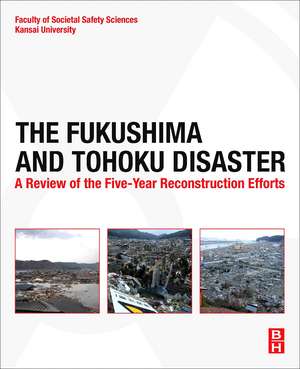The Fukushima and Tohoku Disaster: A Review of the Five-Year Reconstruction Efforts
Editat de School of Societal Safety Sciencesen Limba Engleză Hardback – 15 oct 2017
- Includes guidelines for governments, communities and businesses in areas where similar complex disasters are likely to occur
- Provides information, propositions, suggestions and advice from the people that were involved in making suggestions to the Japanese government
- Features case studies (both pre- and post-disaster) of three simultaneous disasters: the Great East Japan earthquake, the resulting tsunami, and the Fukushima Nuclear Power Plant disaster
Preț: 701.28 lei
Preț vechi: 976.94 lei
-28% Nou
Puncte Express: 1052
Preț estimativ în valută:
134.19€ • 140.46$ • 111.69£
134.19€ • 140.46$ • 111.69£
Carte tipărită la comandă
Livrare economică 24 martie-07 aprilie
Preluare comenzi: 021 569.72.76
Specificații
ISBN-13: 9780128140789
ISBN-10: 012814078X
Pagini: 354
Dimensiuni: 191 x 235 x 24 mm
Greutate: 0.9 kg
Editura: ELSEVIER SCIENCE
ISBN-10: 012814078X
Pagini: 354
Dimensiuni: 191 x 235 x 24 mm
Greutate: 0.9 kg
Editura: ELSEVIER SCIENCE
Public țintă
Professionals, academics, government agencies interested in disaster preparation, response and mitigationCuprins
1 The Great East Japan Earthquake, a Huge Disaster
1.1 Trouble with policies in recovery and reconstruction
1.1.1 Problems in response at the local community level
1.1.2 Problems in response at the prefecture level
1.1.3 Problems in response by the central government
1.1.4 Causes of delays in incomplete recovery and reconstruction projects
1.1.4.1 Did not learn from past lessons
1.1.4.2 There was no wide-area collaboration
1.1.4.3 Reconstruction Charter was incomplete
1.1.4.4 Actions after the disaster and emergency responses are not reviewed
1.2 Quick overview of the 3.11 tsunami generation mechanism
1.3 Tsunami preparation before and after the 3.11 disaster
1.3.1 Tsunami evacuation warnings and advices
1.3.2 Tsunami levee design before the quake
1.3.3 Level-1 (L1) tsunami and Level-2 (L2) tsunami
1.3.4 Problems with constructing tsunami levee
1.4 Troubles in the efforts of revitalizing local communities
1.4.1 Lack of coordination from the start
1.4.2 A case study of Rikuzen Takata pine field
1.4.3 House rebuilding out-of-sync
1.5 Promoting disaster mitigation policies
1.5.1 Newly developed disaster mitigation policies
1.5.2 “The worst disaster scenario and “disaster prevention and mitigation in the
mainstream
1.5.3 Disasters at their new stage
1.6 Disaster resilience and homeland reinforcement
1.6.1 Pictures of new disasters to plan against with Homeland Grand Design 2050
and National Spatial Planning
1.6.2 Disaster resilience
1.6.2.1 Timeline
1.6.2.2 After Action Review (AAR)
1.1 Trouble with policies in recovery and reconstruction
1.1.1 Problems in response at the local community level
1.1.2 Problems in response at the prefecture level
1.1.3 Problems in response by the central government
1.1.4 Causes of delays in incomplete recovery and reconstruction projects
1.1.4.1 Did not learn from past lessons
1.1.4.2 There was no wide-area collaboration
1.1.4.3 Reconstruction Charter was incomplete
1.1.4.4 Actions after the disaster and emergency responses are not reviewed
1.2 Quick overview of the 3.11 tsunami generation mechanism
1.3 Tsunami preparation before and after the 3.11 disaster
1.3.1 Tsunami evacuation warnings and advices
1.3.2 Tsunami levee design before the quake
1.3.3 Level-1 (L1) tsunami and Level-2 (L2) tsunami
1.3.4 Problems with constructing tsunami levee
1.4 Troubles in the efforts of revitalizing local communities
1.4.1 Lack of coordination from the start
1.4.2 A case study of Rikuzen Takata pine field
1.4.3 House rebuilding out-of-sync
1.5 Promoting disaster mitigation policies
1.5.1 Newly developed disaster mitigation policies
1.5.2 “The worst disaster scenario and “disaster prevention and mitigation in the
mainstream
1.5.3 Disasters at their new stage
1.6 Disaster resilience and homeland reinforcement
1.6.1 Pictures of new disasters to plan against with Homeland Grand Design 2050
and National Spatial Planning
1.6.2 Disaster resilience
1.6.2.1 Timeline
1.6.2.2 After Action Review (AAR)
